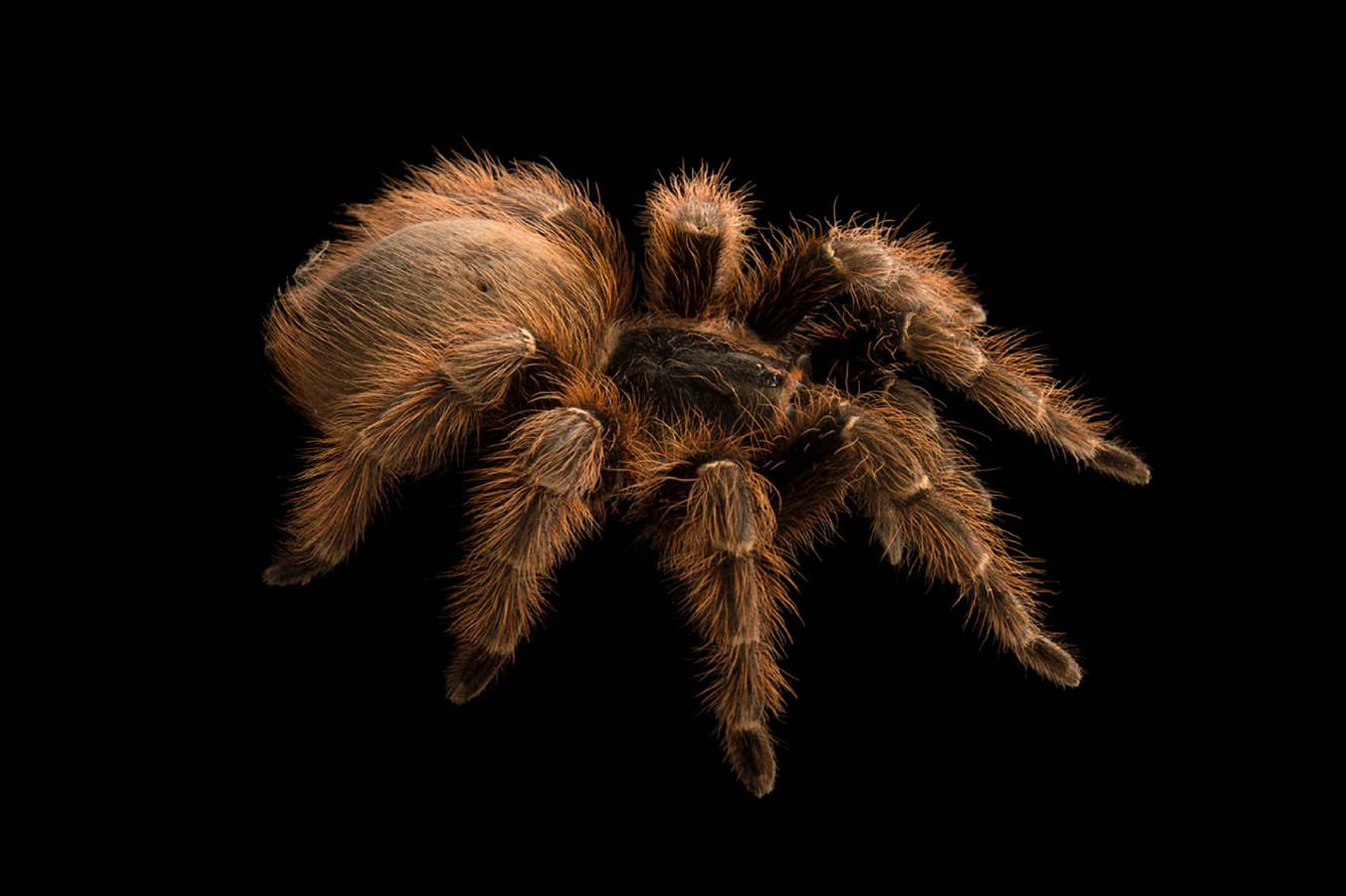

Due to the pink zebra beauty tarantula’s docile nature and low-maintenance care needs, they are considered to be one of the most popular species to keep as pets and could be a good option for first-time tarantula owners. In this guide, we will discuss all aspects of owning a pink zebra beauty tarantula so that you can decide whether these spiders are a good fit for you and your home.

Quick Facts About Pink Zebra Beauty Tarantulas
| Species Name: | Eupalaestrus campestratus |
| Family: | Theraphosidae |
| Care Level: | Low |
| Tank Temperature: | 75-80° Fahrenheit |
| Temperament: | Calm, gentle |
| Color Form: | Dark brown body with light pink markings on its legs |
| Lifespan: | Females can live for up to 20 years; males live to be about 7 years old |
| Size (Maximum Legspan): | 5-6 inches |
| Diet: | Insects such as crickets, roaches, and mealworms; occasionally larger animals such as pinkie mice |
| Minimum Tank Size: | 5-10 gallon terrarium with ample floor space |
| Tank Set-Up: | Substrate of potting soil or peat moss (4 inches deep) on the bottom of terrarium; rocks, bark, or other terrarium decor; high humidity (65-75%); avoid bright lights |
| Compatibility: | Not compatible with other tarantulas |
Pink Zebra Beauty Tarantula Overview
The pink zebra beauty tarantula is a terrestrial tarantula that is indigenous to Paraguay, Argentina, and Brazil. Although they aren’t the easiest tarantulas to come by, they are excellent spiders for beginners. Compared to other species of tarantulas, pink zebra beauty tarantulas are relatively inactive, particularly during the day or when the lights are on. If you want to observe these spiders in action, your best bet is to dim the lights as much as possible and make sure there isn’t too much noise or activity that could disturb your spider.
How Much Do Pink Zebra Beauty Tarantulas Cost?
In the past, pink zebra beauty tarantulas have been relatively difficult for prospective pet owners to find because they were typically caught in the wild. Despite their docile nature, these spiders are not easy to catch. Because they were relatively rare, they used to be fairly expensive.
Now that they are bred in captivity, however, pink zebra beauty tarantulas are more affordable. You can expect to pay around $30-$70 for each spider. This species is popular, so many pet stores will have them, but you can also find them online.
Typical Behavior & Temperament
Pink zebra beauty tarantulas are known for their gentle demeanor, which is what makes them ideal pets. Unlike other tarantulas, they are typically slow-moving creatures that are relatively easy to handle. However, handling your tarantula isn’t advisable, especially if you are a new tarantula owner. Their exoskeletons are very fragile and even a short fall could rupture their abdomen. To be safe, limit handling unless it’s absolutely necessary.
Appearance
Pink zebra beauty tarantulas have dark brown bodies with yellow stripes near their patellae. They have a pinkish hue, hence their name. They look very similar to the Grammostola pulchripes, or the Chaco golden knee, but they are much smaller at about 6 inches wide.

How to Take Care of Pink Zebra Beauty Tarantulas
Habitat, Tank Conditions & Setup
When setting up your pink zebra beauty tarantula’s habitat, you should keep its tropical origins in mind. These spiders prefer dark, warm, and humid climates, so you should try to mimic this habitat as much as possible.
Terrarium
Your pink zebra beauty tarantula’s terrarium should be at least 5-10 gallons large. These spiders aren’t big climbers, so a terrarium with a large surface area on the bottom of the tank is ideal. Place the tank in a low-traffic area of your home away from any bright lights. These spiders don’t like bright lights and will likely stay hidden as long as the lights are on. Because of this, you don’t need to add any extra lights to the terrarium.
Substrate and Decor
Pink zebra beauty tarantulas like to burrow, so it is important that the substrate, or the base of the terrarium, is relatively deep. Aim for a substrate that is at least 4 inches deep. In terms of the actual material, these spiders aren’t too picky—you could use either potting soil or peat moss. You need to achieve humidity in your spider’s terrarium, so whatever substance you use should be able to soak up water. If you aren’t sure what to buy, you could go with prepackaged substrate intended for pet terrariums, which you can find at your local pet store.
In addition to the base substrate, you should consider adding some other types of decor that your spider can use for burrowing, such as a big piece of bark or rocks.
Temperature and Humidity
When it comes to the temperature and humidity of your pink zebra beauty tarantula’s terrarium, remember your spider’s origins. They are used to warm, humid climates and will do well in a terrarium that is humid and warm. The temperature should be between 75-80° F, with 65-75% humidity. You should overflow your spider’s water dish not only to ensure that she remains hydrated but also to maintain a high level of humidity in the terrarium. You can also lightly mist the substrate, but be careful not to do this too often; your spider’s environment should be moist, not wet. Any time you mist, be careful not to mist your spider.
Do Pink Zebra Beauty Tarantula Get Along with Other Pets?
Unless you are actively trying to mate your tarantulas, you should always keep them in their own separate terrariums. They are not communal animals, and in fact, have been known to be cannibalistic in nature. Additionally, tarantula bites are not typically fatal in humans, but they can be fatal in other pets such as cats and dogs. Should your pink zebra beauty tarantula escape from its terrarium, it’s possible that they could bite your furry friends, especially if provoked. That being said, as long as your tarantula stays in its terrarium, you should have no issues if you have other pets.

What to Feed Your Pink Zebra Beauty Tarantula
In terms of food, your spider will prefer moderately sized live insects, such as crickets or mealworms. They can occasionally eat creatures that are about their size, such as pinkie mice or geckos. Tarantulas are low-maintenance in that they only need to be fed a few insects about once a week.
Keeping Your Pink Zebra Beauty Tarantula Healthy
Pink zebra beauty tarantulas are very hardy animals. As mentioned, they don’t need to be fed very often, and as long as their environment is satisfactory, they are fairly self-sufficient creatures. Unlike other animals, you don’t need to change the substrate out very often—every six months or so is sufficient. However, since the terrarium is such a humid environment, you should make sure there are no issues such as mold. If so, you may need to change the substrate out completely. Another thing to keep in mind is your spider’s overall environment. If they are subjected to lots of noise and bright lights or have no ability to burrow, they may become stressed. If your spider refuses to eat for long periods of time or seems to be confined to one area of the terrarium, consider making some changes to her environment to see if that improves her mood.
Breeding
If you intend to breed your pink zebra beauty tarantula, there are a few things you should know. First of all, as mentioned earlier, tarantulas can be cannibalistic. To prevent your female spider from eating the male spider, you should ensure she is well-fed before you begin the breeding process. You should also keep track of your female pink zebra beauty’s molting schedule. If she hasn’t molted in a while, she will likely refuse to mate.
You will need to closely observe the mating process to prevent any problems. You should always use your female spider’s terrarium for mating and not the other way around. This is to make sure your female pink zebra beauty is as comfortable as possible. If it becomes clear that the female is not interested in the male, you should remove the male to ensure that the spiders don’t fight or try to eat one another. A male tarantula will attempt to get the female’s attention by “drumming” the substrate with its legs. If your female is interested in mating, she will drum in return and you will see them slowly start to approach one another.
Once your female has been successfully inseminated, she will begin creating her egg sac. This process can take 6-7 months. You should make sure she is well fed and watered and that her terrarium is entirely undisturbed so that she feels safe. Once the eggs begin to develop legs and develop into the nymph stage, you should remove them from their mother and place them in their own separate enclosures; like adult tarantulas, spiderlings have cannibalistic tendencies. These spiders grow rather slowly, so you will need to have some patience while you wait for your spiderlings to develop into fully-fledged spiders. It will take several years for your spiders to reach full maturity.

Are Pink Zebra Beauty Tarantulas Suitable For You?
Because they are becoming more popular, these tarantulas are easier to find than they used to be, which also means they have become reasonably affordable. If you already own a tarantula, these creatures may not be the best option for you unless you plan to purchase a separate terrarium for your spider. They also have a much slower growth rate than other tarantulas, so if you intend to breed them, you may be more interested in other breeds. However, pink zebra beauty tarantulas are an excellent choice for first-time tarantula owners due to their calm temperament and low level of care.
Featured Image Credit: Cagebirds, Shutterstock
Nicole is the proud mom of Baby, a Burmese cat and Rosa, a New Zealand Huntaway. A Canadian expat, Nicole now lives on a lush forest property with her Kiwi husband in New Zealand. She has a strong love for all animals of all shapes and sizes (and particularly loves a good interspecies friendship) and wants to share her animal knowledge and other experts’ knowledge with pet lovers across the globe.






